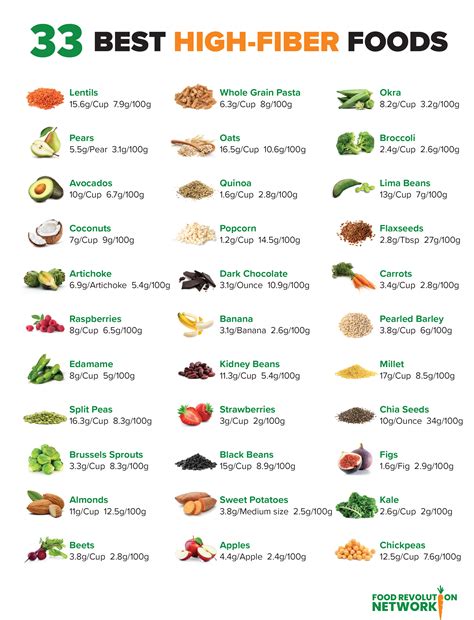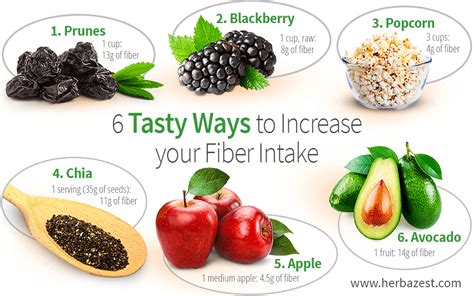Intro
Discover 5 high fiber foods, including fruits, vegetables, and whole grains, that support healthy digestion, boost energy, and promote weight management with soluble and insoluble fiber benefits.
Eating a diet rich in fiber is essential for maintaining good health. Fiber plays a crucial role in digestion, satiety, and blood sugar control. It can also help lower cholesterol levels and reduce the risk of chronic diseases like heart disease, diabetes, and certain cancers. Despite its importance, many people do not consume enough fiber in their daily diets. The average American, for instance, consumes about 15 grams of fiber per day, which is well below the recommended daily intake of 25-30 grams. Increasing fiber intake can be achieved by incorporating high fiber foods into meals and snacks.
Fiber is a type of carbohydrate that is not easily broken down by the body and is therefore not a significant source of energy. However, it provides numerous health benefits, including promoting regular bowel movements, preventing constipation, and supporting healthy gut bacteria. A high fiber diet can also help with weight management by keeping you feeling fuller for longer, thus reducing the likelihood of overeating. Furthermore, fiber can help slow down the absorption of sugar and cholesterol into the bloodstream, which can help regulate blood sugar levels and improve overall cardiovascular health.
The benefits of a high fiber diet are well-documented, and making a conscious effort to include more fiber-rich foods in your diet can have a significant impact on your overall health and wellbeing. High fiber foods include a variety of fruits, vegetables, legumes, whole grains, and nuts. These foods are not only rich in fiber but also provide essential vitamins, minerals, and antioxidants that are vital for maintaining optimal health. By understanding the importance of fiber and incorporating high fiber foods into your diet, you can take a proactive step towards improving your health and reducing the risk of chronic diseases.
Introduction to High Fiber Foods

High fiber foods are those that contain a significant amount of dietary fiber, which is the indigestible part of plant-based foods. These foods can be categorized into several groups, including fruits, vegetables, legumes, whole grains, and nuts. Each of these groups provides a unique set of nutrients and health benefits, making them an essential part of a balanced diet. For example, fruits like apples, bananas, and berries are not only high in fiber but also rich in vitamins, minerals, and antioxidants. Similarly, vegetables like broccoli, carrots, and leafy greens are packed with fiber, vitamins, and minerals, making them an excellent addition to meals and snacks.
Benefits of High Fiber Foods
The benefits of high fiber foods are numerous and well-documented. Some of the key benefits include: * Promoting regular bowel movements and preventing constipation * Supporting healthy gut bacteria and boosting the immune system * Helping to lower cholesterol levels and reduce the risk of heart disease * Regulating blood sugar levels and improving insulin sensitivity * Aiding in weight management by keeping you feeling fuller for longer * Reducing the risk of chronic diseases like diabetes, certain cancers, and cardiovascular diseaseTop 5 High Fiber Foods

Here are five high fiber foods that you should consider incorporating into your diet:
- Avocados: Avocados are a rich source of dietary fiber, containing about 10 grams per medium-sized fruit. They are also rich in healthy fats, vitamins, and minerals, making them an excellent addition to salads, sandwiches, and smoothies.
- Legumes: Legumes, including beans, lentils, and peas, are some of the richest sources of fiber in the diet. They are also rich in protein, vitamins, and minerals, making them an excellent source of nutrition.
- Whole Wheat Spaghetti: Whole wheat spaghetti is a good source of fiber, containing about 4 grams per serving. It is also rich in vitamins, minerals, and antioxidants, making it a healthier alternative to refined pasta.
- Brussels Sprouts: Brussels sprouts are a cruciferous vegetable that is rich in fiber, containing about 5 grams per cup. They are also rich in vitamins, minerals, and antioxidants, making them an excellent addition to meals and snacks.
- Almonds: Almonds are a rich source of fiber, containing about 3 grams per ounce. They are also rich in healthy fats, vitamins, and minerals, making them an excellent snack or addition to oatmeal or yogurt.
Incorporating High Fiber Foods into Your Diet
Incorporating high fiber foods into your diet can be easy and delicious. Here are some tips to get you started: * Start your day with a high fiber breakfast, such as oatmeal with fruit and nuts * Snack on fruits and vegetables throughout the day * Incorporate legumes into your meals, such as adding beans to soups and stews * Choose whole grains over refined grains, such as whole wheat bread and brown rice * Add nuts and seeds to your meals and snacks, such as almonds and chia seedsTips for Increasing Fiber Intake

Increasing fiber intake can be achieved by making a few simple changes to your diet. Here are some tips to get you started:
- Eat a variety of fruits and vegetables, aiming for at least 5 servings per day
- Incorporate legumes into your meals, such as adding beans to soups and stews
- Choose whole grains over refined grains, such as whole wheat bread and brown rice
- Snack on nuts and seeds, such as almonds and chia seeds
- Drink plenty of water to help fiber move through your digestive system
Common Mistakes to Avoid
When increasing fiber intake, there are a few common mistakes to avoid. These include: * Increasing fiber intake too quickly, which can lead to digestive discomfort and bloating * Not drinking enough water, which can lead to constipation and digestive discomfort * Not chewing food properly, which can lead to digestive discomfort and bloating * Eating too much fiber, which can lead to digestive discomfort and bloatingConclusion and Next Steps

In conclusion, incorporating high fiber foods into your diet can have a significant impact on your overall health and wellbeing. By understanding the importance of fiber and making a conscious effort to include more fiber-rich foods in your diet, you can take a proactive step towards improving your health and reducing the risk of chronic diseases. Remember to increase fiber intake gradually, drink plenty of water, and chew food properly to avoid digestive discomfort and bloating. With a little practice and patience, you can make high fiber foods a delicious and sustainable part of your diet.
Final Thoughts
Incorporating high fiber foods into your diet is a simple and effective way to improve your overall health and wellbeing. By making a few simple changes to your diet and lifestyle, you can increase your fiber intake and reap the numerous health benefits that come with it. Remember to stay consistent, be patient, and seek support from healthcare professionals or registered dietitians if you need guidance or advice.What are the benefits of a high fiber diet?
+A high fiber diet can help promote regular bowel movements, support healthy gut bacteria, and reduce the risk of chronic diseases like heart disease, diabetes, and certain cancers.
How much fiber should I eat per day?
+The recommended daily intake of fiber is 25-30 grams per day. However, the average American consumes about 15 grams per day, which is well below the recommended amount.
What are some high fiber foods that I can incorporate into my diet?
+Some high fiber foods include avocados, legumes, whole wheat spaghetti, Brussels sprouts, and almonds. You can also incorporate other fruits, vegetables, whole grains, and nuts into your diet to increase your fiber intake.
How can I increase my fiber intake without experiencing digestive discomfort?
+To increase your fiber intake without experiencing digestive discomfort, start by adding small amounts of fiber to your diet and gradually increase your intake over time. Also, make sure to drink plenty of water and chew your food properly to help fiber move through your digestive system.
Can I take fiber supplements if I'm having trouble getting enough fiber from food sources?
+While fiber supplements can be helpful, it's always best to get your fiber from whole food sources whenever possible. Fiber supplements can be beneficial if you're having trouble getting enough fiber from food sources, but be sure to talk to your healthcare provider before starting any new supplements.
We hope this article has provided you with a comprehensive understanding of the importance of high fiber foods and how to incorporate them into your diet. If you have any further questions or would like to share your experiences with high fiber foods, please don't hesitate to comment below. Additionally, if you found this article helpful, please share it with your friends and family to help spread the word about the benefits of a high fiber diet.
